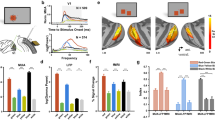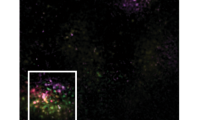Abstract
Many neurons in area TE of the macaque respond selectively to colors or forms. One problem remaining is how these neurons contribute to conjunctive perception of these features when there are many objects in their receptive fields. In order to investigate the effects of learning on neural activities for the conjunction of color and form, neurons were recorded during a visual fixation task and two go/no-go visual discrimination tasks. One discrimination task involved conjunction of color and form for successively presented colored patterns. In this task, the monkeys were required to hold two “go” stimuli in the transient memory. The other task involved associative discrimination between the form of gray patterns and the color of irregular textures when the two features were presented simultaneously at separate locations. Each of the two stimuli was neutral in the go/no-go behavior in the latter task. One third of responsive neurons showed a significant interaction of color and form in response to the colored patterns during the conjunction task. Responses of these neurons were mostly enhanced for a particular colored pattern, which was usually one of the go stimuli. The response enhancement was preserved when the go stimulus was presented with a distractor. However, this change was not seen during the associative discrimination task. During the fixation task, the neurons that showed interaction of color and form in the conjunction task were usually selective either for the forms of gray patterns or colors of irregular textures, and only a few neurons were selective for both. The results indicate that neurons in area TE can conjoin color and form actively for an object held in the working memory, suppressing illusory conjunction.






Similar content being viewed by others
References
Bacon WF, Egeth HE (1997) Goal-directed guidance of attention: evidence from conjunctive visual search. J Exp Psychol Hum Percept Perform 23 948–961
Baker CI, Behrmann M, Olson CR (2002) Impact learning on representation of parts and wholes in monkey inferotemporal cortex. Nature Neurosci 5:1210–1216
Baylis GC, Rolls ET (1987) Responses of neurons in the inferior temporal cortex in short term and serial recognition memory tasks. Exp Brain Res 65:614–622
Buckley MJ, Gaffan D, Murray EA (1997) Functional double dissociation between two inferior temporal cortical areas: perirhinal cortex versus middle temporal gyrus. J Neurophysiol 77:587–598
Bussey TJ, Saksida LM (2002) The organization of visual object representations: a connectionist model of effects of lesions in perirhinal cortex. Eur J Neurosci 15:355–364
Bussey TJ, Wise SP, Murray EA (2002) Interaction of ventral and orbital prefrontal cortex with inferotemporal cortex in conditional visuomotor learning. Behav Neurosci 116:703–715
Chelazzi L, Duncan J, Miller EK, Desimone R (1998) Responses of neurons in inferior temporal cortex during memory-guided visual search. J Neurophysiol 80:2918–2940
Desimone R, Albright TD, Gross CG, Bruce C (1984) Stimulus-selective properties of inferior temporal neurons in the macaque. J Neurosci 4:2051–2062
Duncan J (1984) Selective attention and the organization of visual information. J Exp Psychol Gen 113:501–517
Egeth HE, Virzi RA, Garbart H (1984) Searching for conjunctively defined targets. J Exp Psychol Hum Percept Perform 10:32–39
Fuster JM (1990) Inferotemporal units in selective visual attention and short-term memory. J Neurophysiol 64:681–697
Gaffan D, Harrison S (1988) Inferotemporal-frontal disconnection and fornix transection in visuomotor conditional learning by monkeys. Behav Brain Res 31:149–163
Gallant JL, Connor CE, Rakshit S, Lewis JW, Van Essen DC (1996) Neural responses to polar, hyperbolic, and Cartesian gratings in area V4 of the macaque monkey. J Neurophysiol 76:2718–2739
Gilbert CD, Wiesel TN (1989) Columnar specifity of intrinsic horizontal and corticocortical connections in cat visual cortex. J Neurosci 9:2432–2442
Gross CG, Rocha-Miranda CE, Bender DB (1972) Visual properties of neurons in inferotemporal cortex of the macaque. J Neurophysiol 35:96–111
Haenny PE, Schiller PH (1988) State dependent activity in monkey visual ocrtex. I. Single cell activity in V1 and V4 on visual tasks. Exp Brain Res 69:225–244
Heywood CA, Schields C, Cowey A (1988) The involvement of the temporal lobes in colour discrimination. Exp Brain Res 71:437–441
Hikosaka K (1997) Responsiveness of neurons in the posterior inferotemporal cortex to visual patterns in the macaque monkey. Behav Brain Res 89:275–283
Humphreys GW (2003) Conscious visual representations build from multiple binding processes: evidence from neuropsychology. Prog Brain Res 142:243–255
Huxlin KR, Saunders RC, Marchionini D, Pham H-A, Merigan WH (2000) Perceptual deficits after lesions of inferotemporal cortex in macaques. Cereb Cortex 10:671–683
Kobatake E, Wang G, Tanaka K (1998) Effects of shape-dicrimination training on the selectivity of inferotemporal cells in adult monkeys. J Neurophysiol 80: 324–330
Komatsu H (1982) Prefrontal unit activity during a color discrimination task with GO and NO-GO responses in the monkey. Brain Res 244:269–277
Komatsu H, Ideura Y (1993) Relationships between color, shape, and pattern selectivities of neurons in the inferior temporal cortex of the monkey. J Neurophysiol 70:677–694
Komatsu H, Ideura Y, Kaji S, Yamane S (1992) Color selectivity of neurons in the inferior temporal cortex of the awake macaque monkey. J Neruosci 12:408–424
Lee D, Chun MM (2001) What are the units of visual short-term memory, objects or spatial locations? Percept Psychophysics 63:253–257
Logothetis NK, Pauls J, Poggio T (1995) Shape representation in the inferior temporal cortex of monkeys. Curr Biol 5:552–563
Luck SJ, Vogel EK (1997) The capacity of visual working memory for features and conjunctions. Nature 390:279–281
Miller EK, Gochin PM, Gross CG (1993) Suppression of visual responses of neurons in inferior temporal cortex of the awake macaque by addition of a second stimulus. Brain Res 616:25–29
Missal M, Vogels R, Chao-Yi L, Orban GA (1999) Shape interactions in Macaque inferior temporal neurons. J Neurophysiol 82:131–142
Miyashita Y (1988) Neuronal correlate of visual associative long-term memory in the primate temporal cortex. Nature 335:817–820
Moran J, Desimone R (1985) Selective attention gates visual processing in the extrastriate cortex. Science 229:782–784
Motter BC (1994) Neural correlates of attentive selection for color or luminance in extrastriate area V4. J Neurosci 14:2178–2189
Murray EA, Bussey TJ (1999) Perceptual-mnemonic functions of the perirhinal cortex. Trends Cog Sci 3:142–151
Paul MA, Tipper SP (2003) Object-based representations facilitate memeory for inhibitory processes. Exp Brain Res 148:283–289
Pashler H (1987) Detecting conjunctions of color and form: reassessing the serial search hypothesis. Percept Psychophys 41:191–201
Perrett DI, Rolls ET, Caan W (1982) Visual neurones responsive to faces in the monkey temporal cortex. Exp Brain Res 47:329–342
Pollen DA, Nagler M, Daugman J, Kronauer R, Cavanagh P (1984) Use of Gabor elementary functions to probe receptive field substructure of posterior inferotemporal neurons in the owl monkey. Vision Res 24:233–241
Prinzmetal W, Presti DE and Posner MI (1986) Does attention affect visual feature integration? J Exp Psychol Hum Percept Perform 12:361–369
Richmond BJ, Wurtz RH, Sato T (1983) Visual responses of inferior temporal neurons in awake rhesus monkey. J Neurophysiol 50:1415–1432
Richmond BJ, Optican LM, Podell M, Spitzer H (1987) Temporal encoding of two-dimensional patterns by single units in primate inferotemporal cortex. I. Response characteristics. J Neurophysiol 57:132–146
Ridley RM, Hester NS, Ettlinger G (1977) Stimulus- and response-dependent units from the occipital and temporal lobes of the unanaesthetized monkey performing learnt visual tasks. Exp Brain Res 27:539–552
Rolls ET, Tovee MJ (1995) The responses of single neurons in the temporal visual cortical areas of the macaque when more than on stimulus is presented in the receptive field. Exp Brain Res 103:409–420
Rolls ET, Judge SJ, Sanghera MK (1977) Activity of neurones in the inferotemporal cortex of the alert monkey. Brain Res 130:229–238
Sakagami M, Niki H (1994) Encoding of behavioral significance of visual stimuli by primate prefrontal neurons: relation to relevant task conditions. Exp Brain Res 97:423–436
Sa’ry G, Vogels R, Orban GA (1995) Cue-invariant shape selectivity of macaque inferior temporal neurons. Science 260:995–997
Sato T (1988) Effects of attention and stimulus interaction on visual responses of inferior temporal neurons in macaque. J Neurophysiol 60:344–364
Sato T (1989) Interaction of visual stimuli in the receptive fields of inferior temporal neurons in awake macaques. Exp Brain Res 77:23–30
Sato T (1995) Interactions between two different visual stimuli in the receptive fields of inferior temporal neurons in macaques during matching behaviors. Exp Brain Res 105:209–219
Sato T, Kawamura T, Iwai E (1980) Responsiveness of inferotemporal single units to visual pattern stimuli in monkeys performing discrimination. Exp Brain Res 38:313–319
Schneider W, Shiffrin RM (1977) Controlled and automatic human information processing: I. Detection, search, and attention. Psychol Rev 84:1–66
Schwartz EL, Desimone R, Albright TD, Gross CG (1983) Shape recognition and inferior temporal neurons. Proc Natl Acad Sci U S A 80: 5776–5778
Seltzer B, Pandya DN (1978) Afferent cortical connections and architectonics of the superior temporal sulcus and surrounding cortex in the rhesus monkey. Brain Res 149:1–24
Sigala N, Logothetis NK (2002) Visual categorization shapes feature selectivity in the primate temporal cortex. Nature 415:318–320
Tanaka K, Saito H, Fukuda Y, Moriya M (1991) Coding visual images of objects in the inferotemporal cortex of the macaque monkey. J Neurophysiol 66:170–189
Treisman AM, Gelade G (1980) A feature-integration theory of attention. Cognitive Psychol 12:97–136
Treisman A, Schmidt H (1982) Illusory conjunctions in the perception of objects. Cognitive Psychol 14:107–141
Vogels R, Orban GA (1994) Activity of inferior temporal neruons during orientation discrimination with successively presented gratings. J Neurophysiol 71:1428–1451
Vogels R, Sa’ry G, Orban GA (1995) How task-related are the responses of inferior temporal neurons? Vis Neurosci 12:207–214
Wolfe JM, Cave KR, Franzel SL (1989) Guided search: an alternative to the feature integration model for visual search. J Exp Psychol Hum Percept Perform 15:419–433
Author information
Authors and Affiliations
Corresponding author
Rights and permissions
About this article
Cite this article
Sato, T. Effects of learning on color-form conjunction in macaque inferior temporal neurons. Exp Brain Res 162, 265–277 (2005). https://doi.org/10.1007/s00221-004-2150-4
Received:
Accepted:
Published:
Issue Date:
DOI: https://doi.org/10.1007/s00221-004-2150-4




